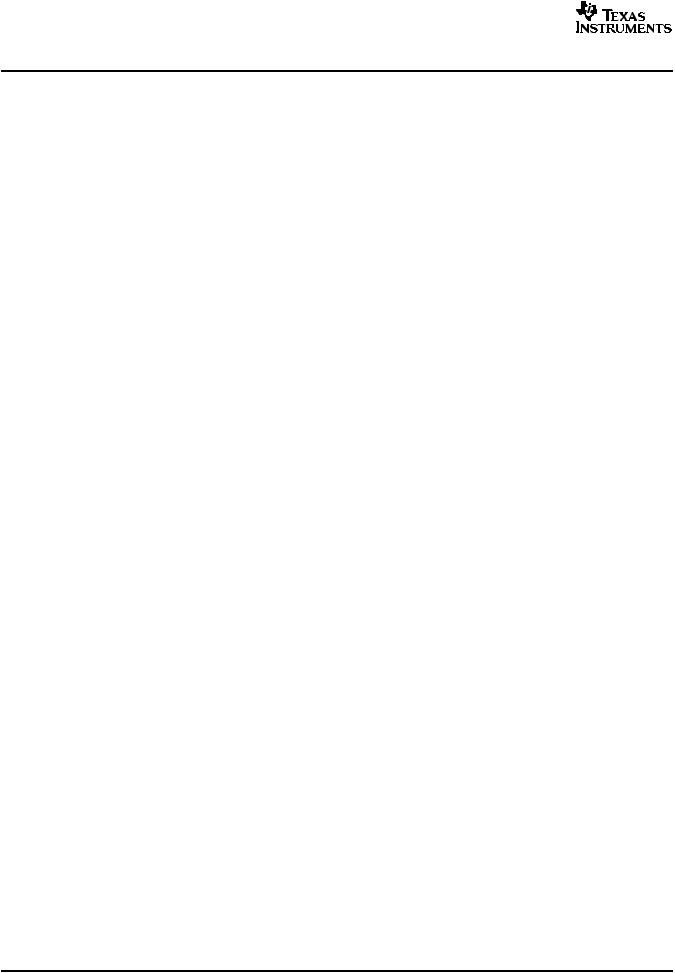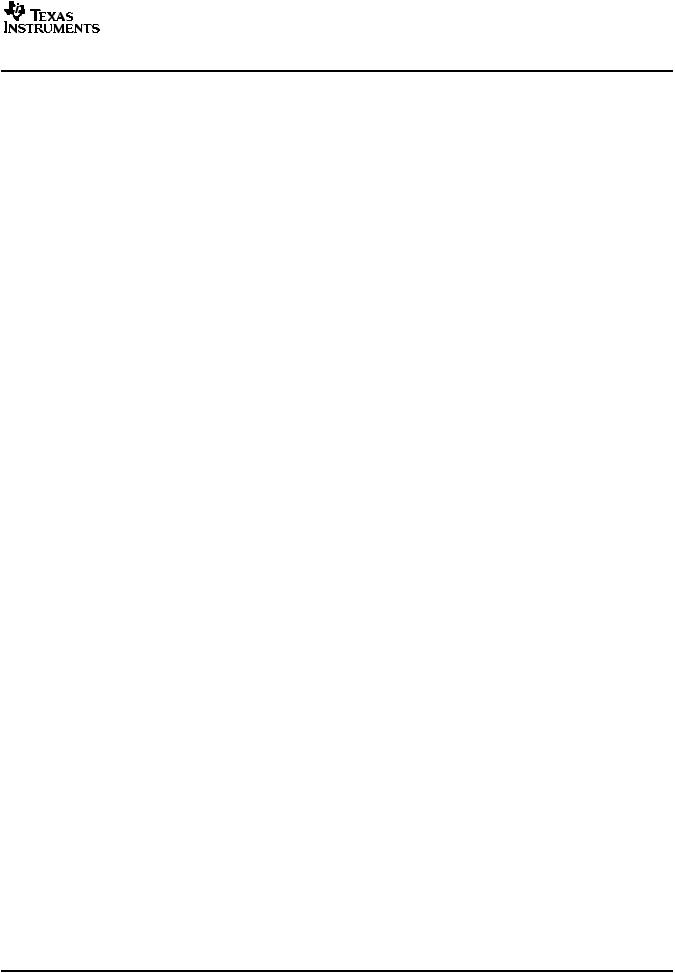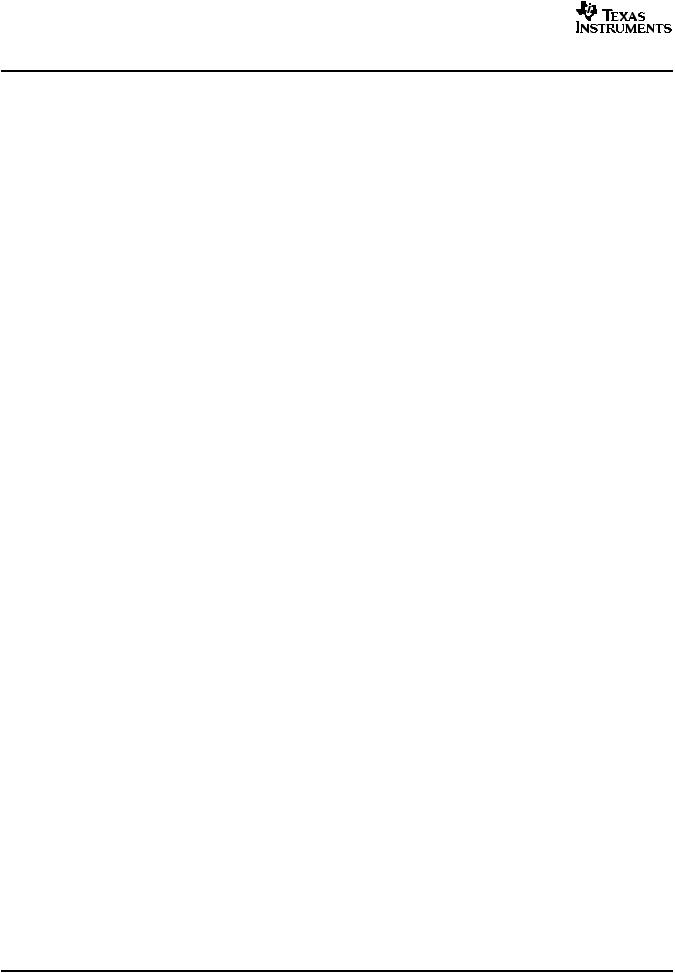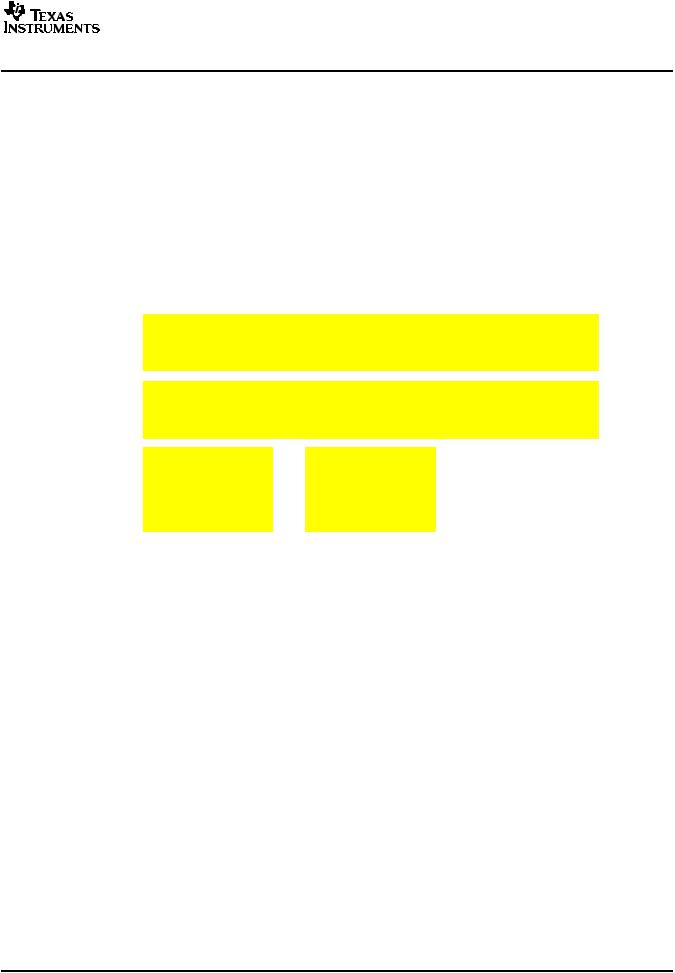
- •Table of Contents
- •Preface
- •1 Introduction
- •1.2 Development Flow
- •2 Getting Started Quickly
- •2.1 Launching the Code Composer Studio IDE
- •2.1.1 Important Icons Used in Code Composer Studio
- •2.2 Creating a New Project
- •2.3 Building Your Program
- •2.4 Loading Your Program
- •2.5 Basic Debugging
- •2.5.1 Go to Main
- •2.5.2 Using Breakpoints
- •2.5.3 Source Stepping
- •2.5.4 Viewing Variables
- •2.5.5 Output Window
- •2.5.6 Symbol Browser
- •2.6 Introduction to Help
- •3 Target and Host Setup
- •3.1 Setting Up the Target
- •3.1.1 Code Composer Studio Setup Utility
- •3.1.2 Parallel Debug Manager
- •3.1.3 Connect/Disconnect
- •3.2 Host IDE Customization
- •3.2.1 Default Colors and Faults
- •3.2.2 Default Keyboard Shortcuts
- •3.2.3 Other IDE Customizations
- •4 Code Creation
- •4.1 Configuring Projects
- •4.1.1 Creating a Project
- •4.1.2 Project Configurations
- •4.1.3 Project Dependencies
- •4.1.4 Makefiles
- •4.1.5 Source Control Integration
- •4.2 Text Editor
- •4.2.1 Viewing and Editing Code
- •4.2.2 Customizing the Code Window
- •4.2.3 Using the Editor's Text Processing Functionality
- •4.2.5 Autocompletion, Tooltips and Variable Watching (CodeSense)
- •4.2.6 Using an External Editor
- •4.3 Code Generation Tools
- •4.3.1 Code Development Flow
- •4.3.2 Project Build Options
- •4.3.3 Compiler Overview
- •4.3.4 Assembly Language Development Tools
- •4.3.5 Assembler Overview
- •4.3.6 Linker Overview
- •4.3.7 C/C++ Development Tools
- •4.4 Building Your Code Composer Studio Project
- •4.4.1 From Code Composer Studio IDE
- •4.4.2 External Make
- •4.4.3 Command Line
- •4.5 Available Foundation Software
- •4.5.1 DSP/BIOS
- •4.5.2 Chip Support Library (CSL)
- •4.5.3 Board Support Library (BSL)
- •4.5.4 DSP Library (DSPLIB)
- •4.5.5 Image/Video Processing Library (IMGLIB)
- •4.5.6 TMS320 DSP Algorithm Standard Components
- •4.5.7 Reference Frameworks
- •4.6 Automation (for Project Management)
- •4.6.1 Using General Extension Language (GEL)
- •4.6.2 Scripting Utility
- •5 Debug
- •5.1 Setting Up Your Environment for Debug
- •5.1.1 Setting Custom Debug Options
- •5.1.2 Simulation
- •5.1.3 Memory Mapping
- •5.1.4 Pin Connect
- •5.1.5 Port Connect
- •5.1.6 Program Load
- •5.2 Basic Debugging
- •5.2.1 Running/Stepping
- •5.2.2 Breakpoints
- •5.2.3 Probe Points
- •5.2.4 Watch Window
- •5.2.5 Memory Window
- •5.2.6 Register Window
- •5.2.7 Disassembly/Mixed Mode
- •5.2.8 Call Stack
- •5.2.9 Symbol Browser
- •5.2.10 Command Window
- •5.3 Advanced Debugging Features
- •5.3.1 Advanced Event Triggering (AET)
- •5.4 Real-Time Debugging
- •5.5 Automation (for Debug)
- •5.5.1 Using the General Extension Language (GEL)
- •5.5.2 Scripting Utility for Debug
- •5.6 Reset Options
- •5.6.1 Target Reset
- •5.6.2 Emulator Reset
- •6 Analyze/Tune
- •6.1 Application Code Analysis
- •6.1.1 Data Visualization
- •6.1.2 Simulator Analysis
- •6.1.3 Emulator Analysis
- •6.2 Application Code Tuning (ACT)
- •6.2.1 Tuning Dashboard
- •6.2.2 Compiler Consultant
- •6.2.3 CodeSizeTune (CST)
- •6.2.4 Cache Tune
- •7 Additional Tools, Help, and Tips
- •7.1 Component Manager
- •7.1.1 Opening Component Manager
- •7.1.2 Multiple Versions of the Code Composer Studio IDE
- •7.2 Update Advisor
- •7.2.1 Registering Update Advisor
- •7.2.2 Checking for Tool Updates
- •7.2.3 Automatically Checking for Tool Updates
- •7.2.4 Uninstalling the Updates
- •7.3 Additional Help
- •7.3.1 Online Help
- •7.3.2 Online Tutorial

www.ti.com
Available Foundation Software
4.4.3Command Line
4.4.3.1Using the Timake Utility From the Command Line
The timake.exe utility located in the CCStudio_v3.1\cc\bin directory provides a way to build projects (*.pjt) outside of the Code Composer Studio environment from a command prompt. This utility can be used to accomplish batch builds.
To invoke the timake utility:
1.Open a DOS Command prompt.
2.Set up the necessary environment variables by running the batch file DosRun.bat. This batch file must be run before using timake. If you installed the Code Composer Studio product in C:\CCStudio_v3.1, the batch file is located at: C:\CCStudio_v3.1\DosRun.bat.
3.Run the timake utility.
See the online help topic on the timake utility for more information.
4.4.3.2Makefiles
In addition to the option of using external makefiles within the Code Composer Studio IDE, you can also export a standard Code Composer Studio project file (*.pjt) to a standard makefile that can be built from the command line using any standard make utility. Code Composer Studio comes with a standard make utility (gmake) that can be run after running the DosRun.bat file.
To export a Code Composer Studio Project to a standard makefile:
1.Make the desired project active by selecting the project name from the Select Active Project drop-down list on the Project toolbar.
2.Select Project→Export to Makefile.
3.In the Exporting <filename>.pjt dialog box, specify the configurations to export, the default configuration, the host operating system for your make utility, and the file name for the standard makefile.
4.Click OK to accept your selections and generate a standard makefile.
See the online help topic, Exporting a Project to a Makefile for more information.
4.5Available Foundation Software
4.5.1DSP/BIOS
DSP/BIOS™ is a scalable real-time kernel, designed specifically for the TMS320C5000™ , TMS320C2000™, and TMS320C6000™ DSP platforms. DSP/BIOS enables you to develop and deploy sophisticated applications more quickly than with traditional DSP software methodologies and eliminates the need to develop and maintain custom operating systems or control loops. Because multithreading enables real-time applications to be cleanly partitioned, an application using DSP/BIOS is easier to maintain and new functions can be added without disrupting real-time response. DSP/BIOS provides standardized APIs across C2000, C5000, and C6000 DSP platforms to support rapid application migration.
Updated versions of the DSP/BIOS API and configuration tools are available through the Update Advisor. After installing an updated version of DSP/BIOS, you can specify which DSP/BIOS version to be used by CCStudio with the Component Manager.
4.5.2Chip Support Library (CSL)
The Chip Support Library (CSL) provides C-program functions to configure and control on-chip peripherals. It is intended to simplify the process of running algorithms in a real system. The goal is peripheral ease of use, shortened development time, portability, hardware abstraction, and a small level of standardization and compatibility among devices.
40 |
Code Creation |
SPRU509F –May 2005 |

www.ti.com
Available Foundation Software
4.5.2.1Benefits of CSL
CSL has the following benefits:
∙Standard protocol to program peripherals. CSL provides a higher-level programming interface for each on-chip peripheral. This includes data types and macros to define peripheral register configuration, and functions to implement the various operations of each peripheral.
∙Basic resource management. Basic resource management is provided through the use of open and close functions for many of the peripherals. This is especially helpful for peripherals that support multiple channels.
∙Symbol peripheral descriptions. As a side benefit to the creation of CSL, a complete symbolic description of all peripheral registers and register fields has been created. It is suggested that you use the higher-level protocols described in the first two bullets, as these are less device-specific, making it easier to migrate your code to newer versions of DSPs.
4.5.3Board Support Library (BSL)
The TMS320C6000 DSK Board Support Library (BSL) is a set of C-language application programming interfaces (APIs) used to configure and control all on-board devices, allowing developers to get algorithms functioning in a real system. The BSL consists of discrete modules that are built and archived into a library file. Each module represents an individual API and is referred to as an API module. The module granularity is constructed such that each device is covered by a single API module except the I/O Port module, which is divided into two API modules: LED and DIP.
4.5.3.1Benefits of BSL
Some of the advantages offered by the BSL include: device ease of use, a level of compatibility between devices, shortened development time, portability, some standardization, and hardware abstraction.
4.5.4DSP Library (DSPLIB)
The DSP Library (DSPLIB) includes many C-callable, assembly-optimized, general-purpose sig- nal-processing, and image/video processing routines. These routines are typically used in computationally intensive real-time applications where optimal execution speed is critical. By using these routines, you can achieve execution speeds considerably faster than equivalent code written in standard ANSI C language. In addition, by providing ready-to-use DSP and image/video processing functions, DSPLIB and IMGLIB can significantly shorten your application development time.
For more information on DSPLIB, see the appropriate reference guide for your device:
∙TMS320C54x DSP Library Programmer’s Reference (SPRU518)
∙TMS320C55x DSP Library Programmer’s Reference (SPRU422)
∙TMS320C62x DSP Library Programmer’s Reference (SPRU402)
∙TMS320C64x DSP Library Programmer’s Reference (SPRU565)
4.5.4.1Benefits of DSPLIB
DSPLIB includes commonly-used routines. Source code is provided that allows you to modify functions to match your specific needs.
Features include:
∙Optimized assembly code routines
∙C and linear assembly source code
∙C-callable routines fully compatible with the TI Optimizing C compiler
∙Benchmarks (cycles and code size)
∙Tested against reference C model
SPRU509F –May 2005 |
Code Creation |
41 |

www.ti.com
Available Foundation Software
4.5.4.2DSPLIB Functions Overview
DSPLIB provides a collection of C-callable high performance routines that serve as key enablers for a wide range of signal and image/video processing applications.
The routines contained in the DSPLIB are organized into the following functional categories:
∙Adaptive filtering
∙Correlation
∙FFT
∙Filtering and convolution
∙Math
∙Matrix functions
∙Miscellaneous
4.5.5Image/Video Processing Library (IMGLIB)
The Image/Video Processing Library (IMGLIB) includes many C-callable, assembly-optimized, gen- eral-purpose signal-processing, and image/video processing routines. The IMGLIB is only available for C5500/C6000 platform devices. These routines are typically used in computationally intensive real-time applications where optimal execution speed is critical. By using these routines, you can achieve execution speeds faster than equivalent code written in standard ANSI C language. In addition, DSPLIB and IMGLIB can significantly shorten application development time by providing ready-to-use DSP and image/video processing functions.
For more information on IMGLIB, see the appropriate reference guide for your device:
∙TMS32C55x Imaging/Video Processing Library Programmer’s Reference (SPRU037)
∙TMS320C62x Image/Video Processing Library Programmer’s Reference (SPRU400)
∙TMS320C64x Image/Video Processing Library Programmer’s Reference (SPRU023)
4.5.5.1Benefits of IMGLIB
IMGLIB includes commonly used routines. Source code is provided that allows you to modify functions to match your specific needs.
Features include:
∙Optimized assembly code routines
∙C and linear assembly source code
∙C-callable routines fully compatible with the TI Optimizing C compiler
∙Benchmarks (cycles and code size)
∙Tested against reference C model
4.5.5.2IMGLIB Functions Overview
IMGLIB provides a collection of C-callable high performance routines that can serve as key enablers for a wide range of signal and image/video processing applications.
The set of software routines included in the IMGLIB are organized into three different functional categories as follows:
∙Image/video compression and decompression
∙Image analysis
∙Picture filtering/format conversions
42 |
Code Creation |
SPRU509F –May 2005 |

www.ti.com
Available Foundation Software
4.5.6TMS320 DSP Algorithm Standard Components
DSPs are programmed in a mix of C and assembly language, and directly access hardware peripherals. For performance reasons, DSPs have little or no standard operating system support. Unlike gen- eral-purpose embedded microprocessors, DSPs are designed to run sophisticated signal processing algorithms and heuristics. However, because of the lack of consistent standards, it is not possible to use an algorithm in more than one system without significant reengineering. Reusing DSP algorithms is labor intensive, so the time-to-market for a new DSP-based product is lengthy.
The TMS320 DSP Algorithm Standard (known as XDAIS) defines a set of requirements for DSP algorithms that allow system integrators to quickly assemble systems from using one or more such algorithms.
4.5.6.1Scope of XDAIS
Figure 4-14. TMS320 DSP Algorithm Standard Elements
Level 1 |
General Programming Guidelines |
|
|
|
|
||||||||
C callable |
|
|
|
|
Reentrant etc. |
|
|
||||||
|
|
|
|
|
|
|
|||||||
|
No hard coded addresses |
|
|
|
|
|
|
|
|
|
|||
|
|
|
|
|
|
|
|
|
|
|
|||
|
|
|
|
|
|
|
|
|
|
|
|
|
|
Level 2 |
Algorithm Component Model |
|
|
|
|
|
|
|
|
|
|||
Modules |
|
|
|
|
Packaging etc. |
|
|
||||||
|
|
|
|
|
|
|
|||||||
|
Generic Interfaces |
|
|
|
|
|
|
|
|
|
|||
|
|
|
|
|
|
|
|
|
|
|
|
|
|
|
|
|
|
|
|
|
|
|
|
|
|
|
|
Level 3 |
Rules for C62xx |
|
|
Rules for C54xx |
|
Rules for C2xxx |
|||||||
Interrupt usage |
|
|
Interrupt usage |
|
Interrupt usage |
||||||||
|
|
|
|
||||||||||
|
Memory usage |
|
|
Memory usage |
|
Memory usage |
|||||||
|
Register usage |
|
|
Register usage |
|
Register usage |
|||||||
|
etc. |
|
|
etc. |
|
etc. |
|
|
|||||
|
|
|
|
|
|
|
|
|
|
|
|
|
|
|
|
|
|
|
|
|
|
|
|
|
|
|
|
Level 4 |
Telecom |
|
Imaging |
|
|
Audio |
|
|
Automotive |
|
Other |
||
Vocoders |
|
JPEG |
|
|
Coders |
|
|
etc. |
|
|
|||
|
|
|
|
|
|
|
|
||||||
|
Echo cancel |
|
etc. |
|
|
etc. |
|
|
|
|
|
|
|
|
etc. |
|
|
|
|
|
|
|
|
|
|
|
|
|
|
|
|
|
|
|
|
|
|
|
|
|
|
Level 1 contains programming guidelines that apply to all algorithms on all DSP architectures, regardless of application area. Almost all recently developed software modules already follow these guidelines, so this level formalizes them.
Level 2 contains rules and guidelines that enable all algorithms to operate within a single system. Conventions are established for an algorithm’s use of data memory and names for external identifiers, as well as rules for algorithm packaging.
Level 3 contains the guidelines for specific DSP families. There are no current agreed-upon guidelines for algorithms for use of processor resources. These guidelines outline the uses of the various architectures. Deviations from these guidelines may occur, but the algorithm vendor can outline the deviation in the relevant documentation or module headers.
The shaded boxes in Figure 4-14 represent the areas that are covered in this version of the specification.
Level 4 contains the various vertical markets. Due to the inherently different nature of each of these businesses, it seems appropriate for the market leaders to define the interfaces for groups of algorithms based on the vertical market. If each unique algorithm has an interface, the standard will not stay current. At this level, any algorithm that conforms to the rules defined in the top three levels is considered eXpressDSP-compliant.
SPRU509F –May 2005 |
Code Creation |
43 |
